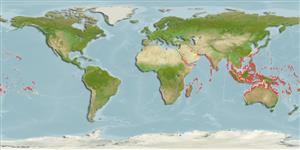>
Eupercaria/misc (Various families in series Eupercaria) >
Labridae (Wrasses) > Corinae
Etymology: Halichoeres: Greek, als, alis = salt + Greek, choiros = pig (Ref. 45335).
More on author: Rüppell.
Environment: milieu / climate zone / depth range / distribution range
Ecologia
marinhas associadas(os) a recifes; intervalo de profundidade 0 - 30 m (Ref. 1602). Tropical; 31°N - 33°S, 33°E - 124°W
Indo-Pacific: Red Sea south to Inhaca Island, Mozambique (Ref. 4392) and east to the Hawaiian (1 specimen) and Tuamoto islands, north to southern Japan, south to the southern Great Barrier Reef and Austral Islands.
Comprimento de primeira maturação / Tamanho / Peso / Idade
Maturity: Lm 7.0 range ? - ? cm
Max length : 18.0 cm TL macho/indeterminado; (Ref. 4392)
Descrição suscinta
Chaves de identificação | Morfologia | Morfometria
Espinhos dorsais (total) : 9; Raios dorsais (total) : 13 - 14; Espinhos anais: 3; Raios anais : 12 - 13. Juveniles are black with numerous longitudinal white streaks (Ref. 1602).
Inhabit lagoon and seaward reefs, along the upper edges of coral-rich areas (Ref. 9710, 58534). Benthopelagic (Ref. 58302). May be solitary or found in small group (Ref. 90102). Juveniles are encountered in exposed outer reef flats (Ref. 1602). Feed on a wide variety of small invertebrates as well as fish eggs.
Ciclo de vida ou comportamento de acasalamento
Maturities | Reprodução | Spawnings | Egg(s) | Fecundities | Larvas
Pelagic spawner. Females migrate to spawning sites, larger females travel long distances to downcurrent areas than smaller ones to protect the eggs from becoming prey to larger reef fishes (Ref. 32198). Spawning sites are chosen by the females irregardless of the males occupying them (Ref. 32198). Females spawn in more than one spawning site, each site occupied by more than one male, which are either territorial or non-territorial (Ref. 32198). After spawning, they return individually to their home ranges without passing through other spawning sites (Ref. 32198). Some females on the other hand change sex after spawning (Ref. 32198). As males, they begin to establish territories in the spawning sites, even to those they visited before the sex change (Ref. 32198). This observation support the suggestion (Warner's 1985, 1986) that females stored information on spawning sites by migrating to various sites which aided in the acquisition of a mating territory after changing sex (Ref. 32198).
Randall, J.E., G.R. Allen and R.C. Steene, 1990. Fishes of the Great Barrier Reef and Coral Sea. University of Hawaii Press, Honolulu, Hawaii. 506 p. (Ref. 2334)
Status na Lista Vermelha da UICN (Ref. 130435)
Ameaça para os humanos
Harmless
Uso pelos humanos
Pescarias: pouco comercial; Aquário: Espécies comerciais
Ferramentas
Relatórios especiais
Baixar XML
Fontes da internet
Estimates based on models
Preferred temperature (Ref.
123201): 25 - 29.3, mean 28.3 °C (based on 3073 cells).
Índice de diversidade filogenética (Ref.
82804): PD
50 = 0.5000 [Uniqueness, from 0.5 = low to 2.0 = high].
Bayesian length-weight: a=0.01047 (0.00607 - 0.01808), b=3.16 (3.01 - 3.31), in cm total length, based on LWR estimates for this species & Genus-body shape (Ref.
93245).
Nível Trófico (Ref.
69278): 3.2 ±0.2 se; based on diet studies.
Generation time: 1.5 ( na - na) years. Estimated as median ln(3)/K based on 1
growth studies.
Resiliência (Ref.
120179): Elevada, tempo mínimo de duplicação da população menor que 15 meses (K=0.7).
Fishing Vulnerability (Ref.
59153): Low vulnerability (20 of 100).
Nutrients (Ref.
124155): Calcium = 89.3 [53.4, 149.2] mg/100g; Iron = 0.784 [0.460, 1.420] mg/100g; Protein = 18.5 [15.6, 20.7] %; Omega3 = 0.15 [0.10, 0.23] g/100g; Selenium = 27 [17, 48] μg/100g; VitaminA = 101 [33, 373] μg/100g; Zinc = 1.73 [1.21, 2.74] mg/100g (wet weight);
